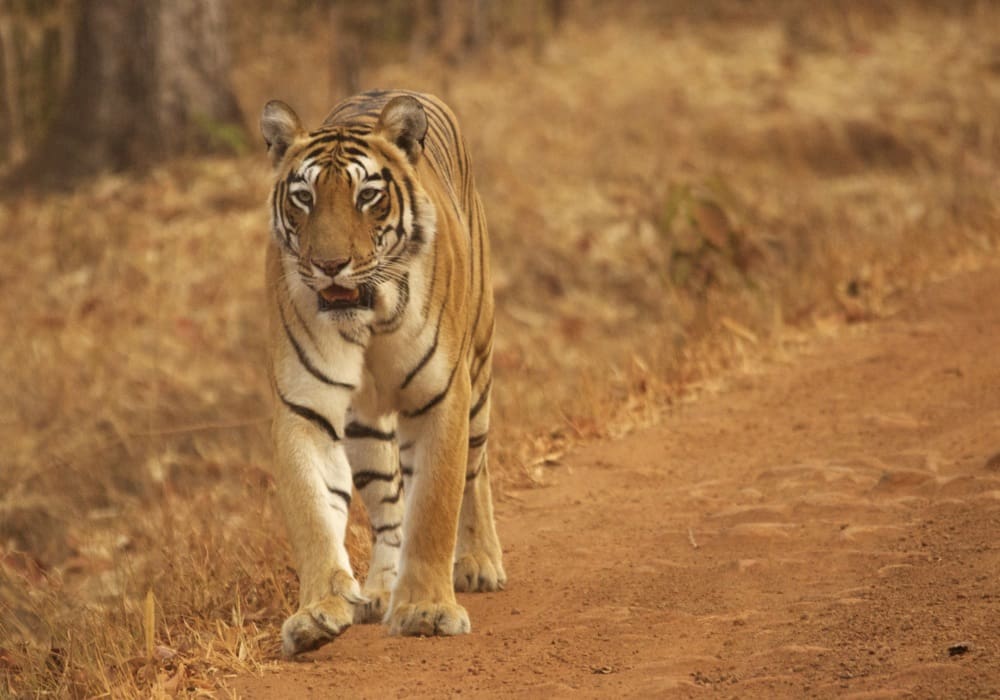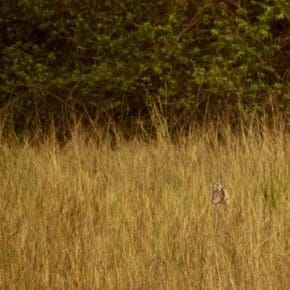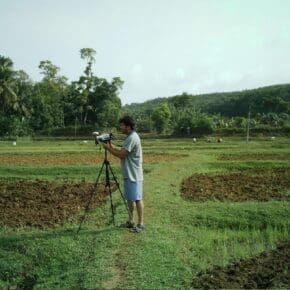In 2016 and 2017 Jamni grassland in Tadoba has been a celebration for tiger-watchers. Choti Tara, the tigress who rules these parts, is bringing up her yet unnamed male cubs. We saw Jamni abound with prey species such as wild boar (Sus scrofa cristatus), sambar (Cervus unicolor) and spotted deer (Axis axis). Birds included Indian Roller (Coracias benghalensis), Chestnut-shouldered Petronia (Gymnoris xanthocollis), Black Ibis (Pseudibis papillosa), Cattle Egret (Bubulcus ibis), White-throated Kingfisher (Halcyon smyrnensis), and Oriental Honey Buzzard (Pernis ptilorhynchus). Tourists made up a fair share of the transient population at Jamni everyday as Choti Tara and her cubs presented themselves as l’attraction principale.
Choti Tara’s cubs were ten months old when we visited at the end of March. The untrained eye could be forgiven for mistaking the cubs for adult tigers as they already looked large. When we first set eyes upon this beautiful family, it was the mother we saw first. She was so well camouflaged in the grass that our patient and persevering guide must have thought of giving up his profession for a moment as he was frustrated by our inability to see what he could see clearly. Yet, when we set our eyes on Choti Tara, and her eyes met ours, we received the same acknowledgement from her that a spectator in the farthest stand in Wimbledon would receive from a finalist. When Choti Tara decided to give us an audience, albeit a fleeting one, she appeared to have been lying down on her side and the head that we saw was perhaps one that bobbed out of an oxymoron called bored interest, to see what the commotion was about.
We had at least ten safari jeeps ahead of us. And the reason we didn’t make it to the top ten was because we, unlike tiger tourists, had stopped to admire nature’s creations in all forms. We had started the day from Telia lake, and we stopped to admire peafowl, Sirkeer Malkoha (Phaenicophaeus leschenaultii), rufous treepies (Dendrocitta vagabunda), a sloth bear (Melursus ursinus) high on Mahua (Madhuca longifolia) fruits, that we saw on the way while the jeeps that entered the park after us raced ahead. We hounded our guide to tell us about the trees in the park. Our safari jeep driver, encouraged by our curiosity, chimed in. On the way to Jamni we stopped to watch spotted deer stags spar for mating rights. We saw two sparring matches twenty metres apart; the vanquished leapt away, while the winner stood his ground.
Our frequent interludes, looking at the sundry denizens and flora of the tiger reserve, must have worried our guide. He alluded that we should do a bit of tiger watching, after which we would have all the time to see everything else. I cannot forget the way he said it in Hindi, assuming the tone of a grandparent chiding a grandchild to finish the food on the plate, after which the child would get all the time to play. That is how we landed up at the rear of a convoy of safari jeeps at Jamni. We were joined by more safari jeeps, and soon had a position at the middle of the queue — relatively speaking.
It was as though Jamni and its populace at that time were getting ready for a stage act. The audience had arrived, the star was backstage, peering through a screen of dry grass at a motley audience, secretly judging their ability to appreciate a class act. As the first act started, we were left stupefied as the presumed star walked off in a huff. Yes, Choti Tara got up and walked further away to where the grasslands and the wooded areas of Jamni merged near the mango tree-line. Looking at our disappointed looks, our guide consoled us, saying that Choti Tara would be back and that perhaps we might see her cubs as well.
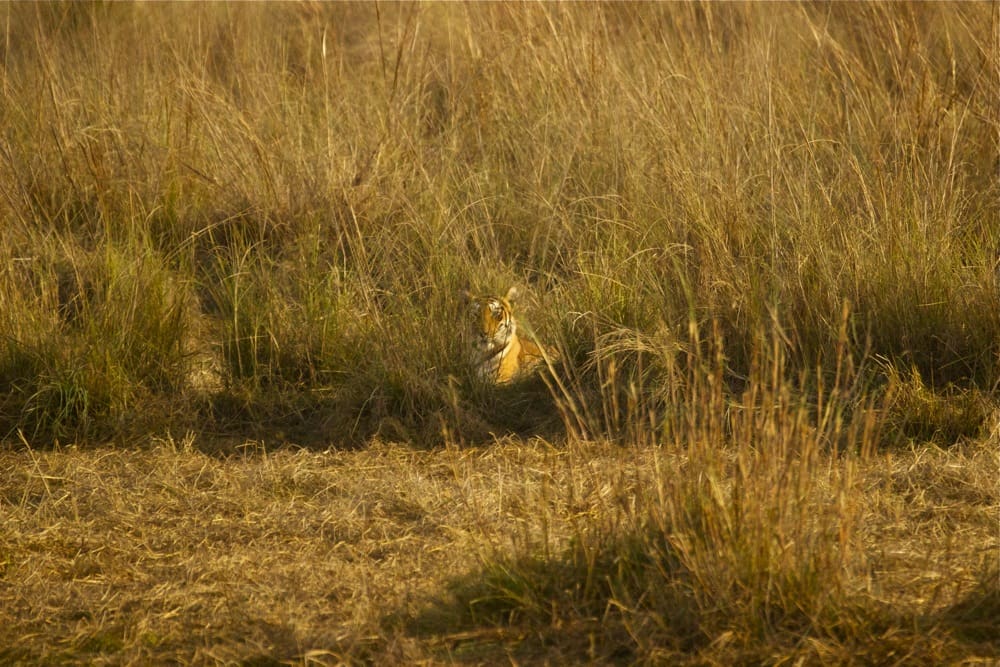
The body language of visitors at the van of the convoy was starting to show signs of distress. As anxious moments passed, the configuration of the convoy shifted with safari jeeps leaving and others occupying the positions of vantage vacated. Tiger safaris are classic examples of hope winning over rationale. We stayed, hoping that Choti Tara would return and that we would get to see the show. The body language by now had turned to that of spectators who had come to watch an exhibition chess match between two grandmasters, only to find out that the players weren’t going to turn up.
As the orange fireball in the background rose higher, it appeared some providential force was setting the chessboard of Jamni on fire. In a game of chess, often it takes just one move by a pawn to set the board on fire.
A wild boar that was foraging on the south side of Jamni at the rear end of the jeep column moved north. A head bobbed out of the patch of grass where Choti Tara lay resting a while ago. The nonchalant wild boar and its opportunistic companion, the cattle egret, continued moving towards the front of the column and further than the first safari jeep. A tiger cub was now out of the grass. The wild boar sensed the hungry eyes of the tiger looking at it. What appeared to be the a spark falling on munitions turned to be a damp squib as the wild boar continued its foraging, irking the novice tiger.
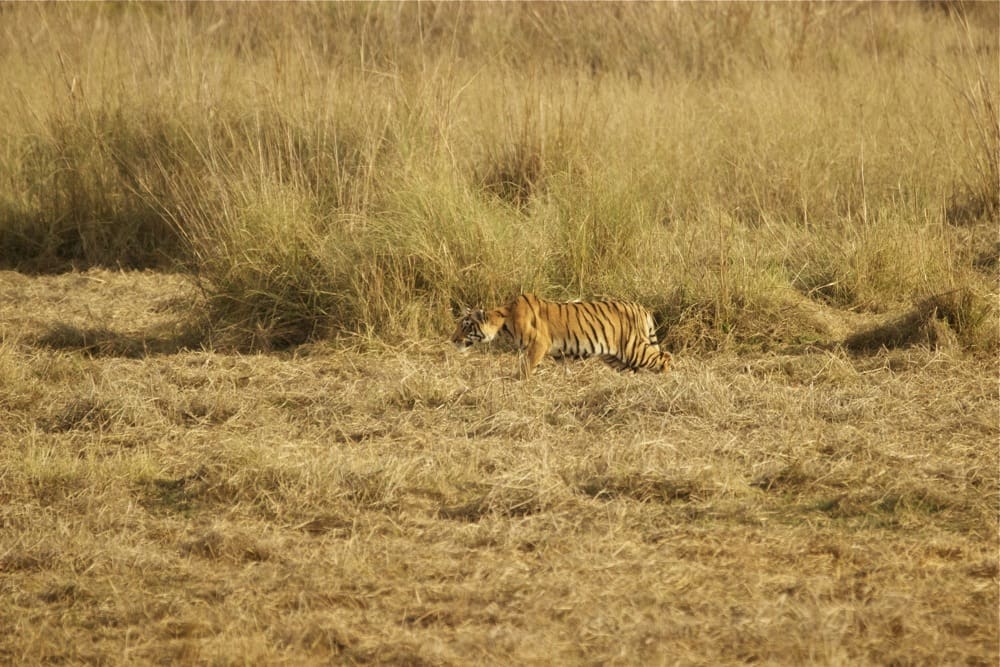
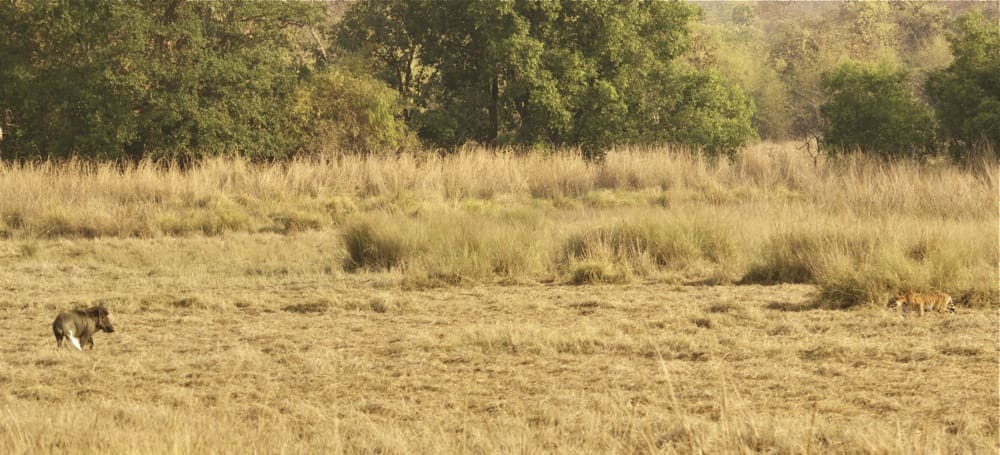
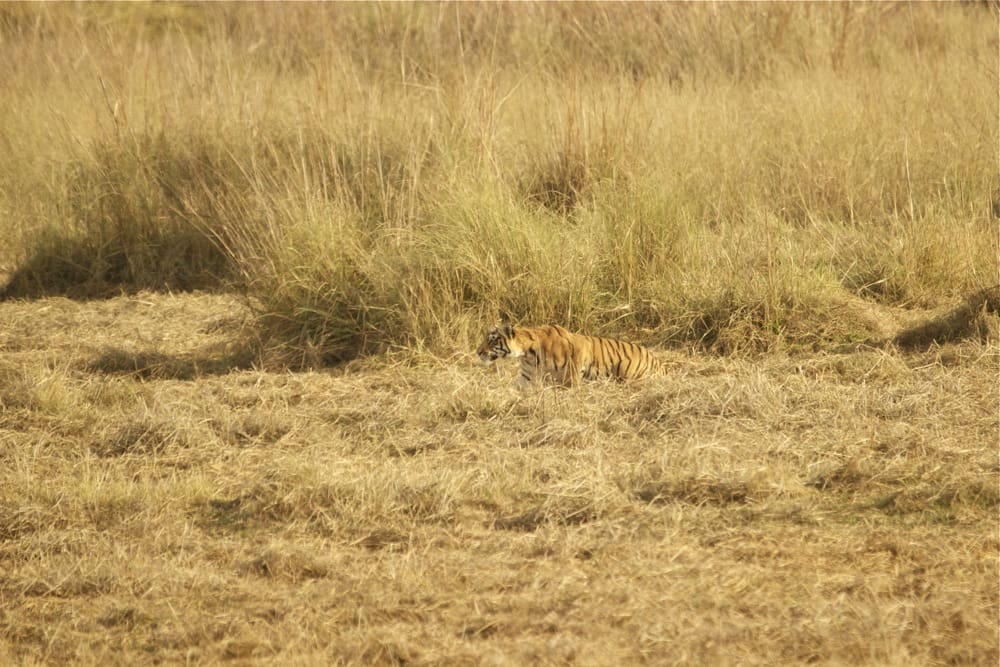
Had there been two tigers, I imagined, this would have been like Asterix and Obelix going to to hunt boars. Within seconds ,the tiger cub was joined by its sibling. And the two started creeping stealthily up to the wild boar. They broke into a trot. The wild boar, startled by its pursuers, began to sprint, and the tiger cubs followed suit.
It was over in a matter of seconds as the wild boar crossed the dirt track in full view of the first jeep. The tiger cubs abandoned their pursuit well ahead of the dirt track, and retreated into the grass. Our wait had paid dividends. We moved ahead, following fresh pugmarks, but not seeing any more tigers on that safari. We wondered if Choti Tara had been secretly watching the bravado of her cubs from behind the cover of the grass.
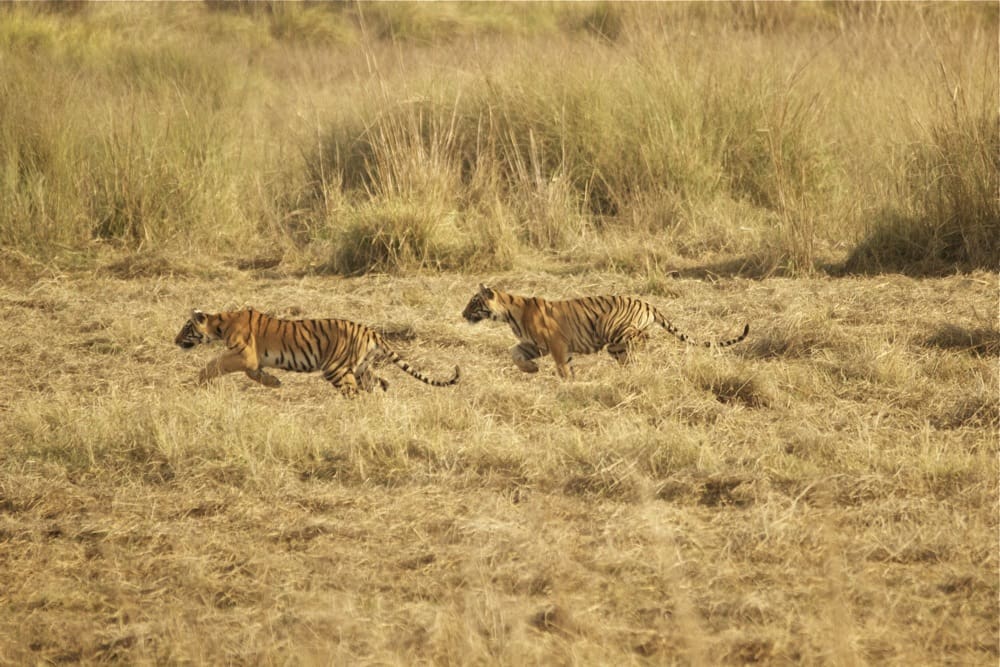
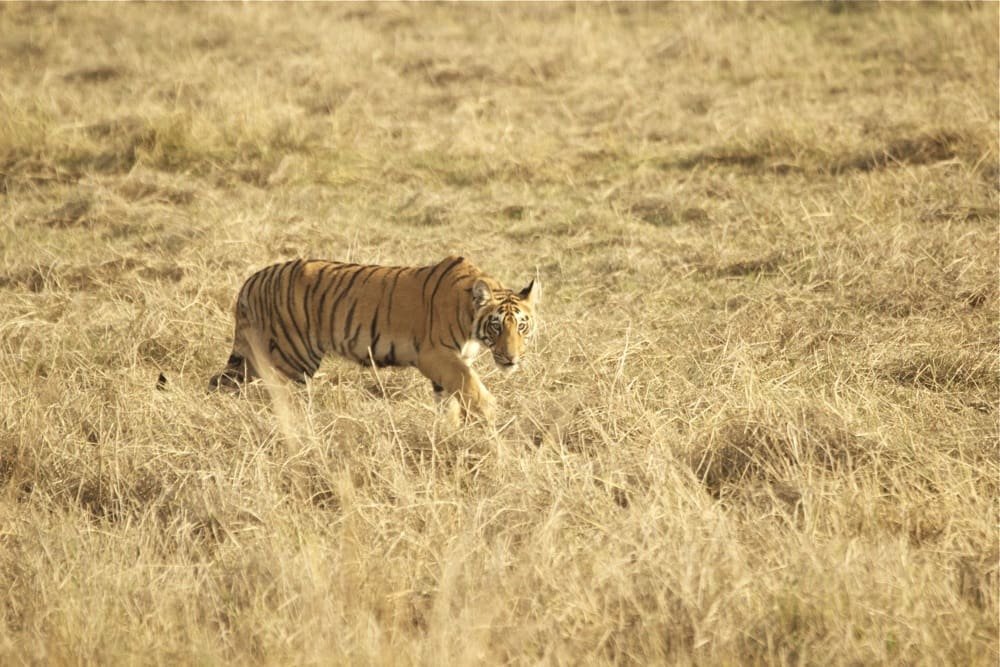
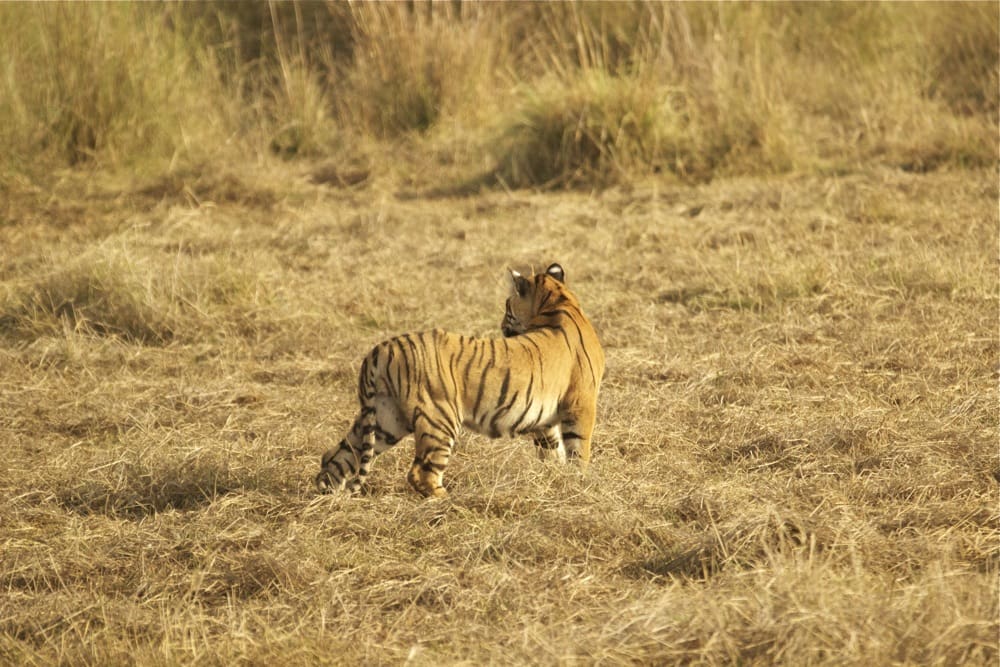
We saw Choti Tara and her cubs again the next evening as they were resting under the shade of the trees at the bund on the south side of Jamni. This time, a herd of spotted deer with fawns approached them, and while one of the cubs got up and approached the herd, we didn’t see the approach culminating in the showdown. The episode played out under the watchful eyes of Choti Tara and only one cub showed activity, while the other lay relaxing. The scene played out about half a kilometre away and binoculars were required to see the tigers clearly. Nevertheless, we were immersed in the show.
On our last safari, we wanted to go to Jamni again to see if we could get a picture of Choti Tara and her cubs in the same frame. About 200 metres before Jamni, we joined a party of six jeeps, right at the back. We heard a tiger call to our right: “Aurm… aurm!” Choti Tara appeared. She walked towards our jeep and crossed in front of the jeep ahead of us to the left. Then she continued along the natural path in the forest.
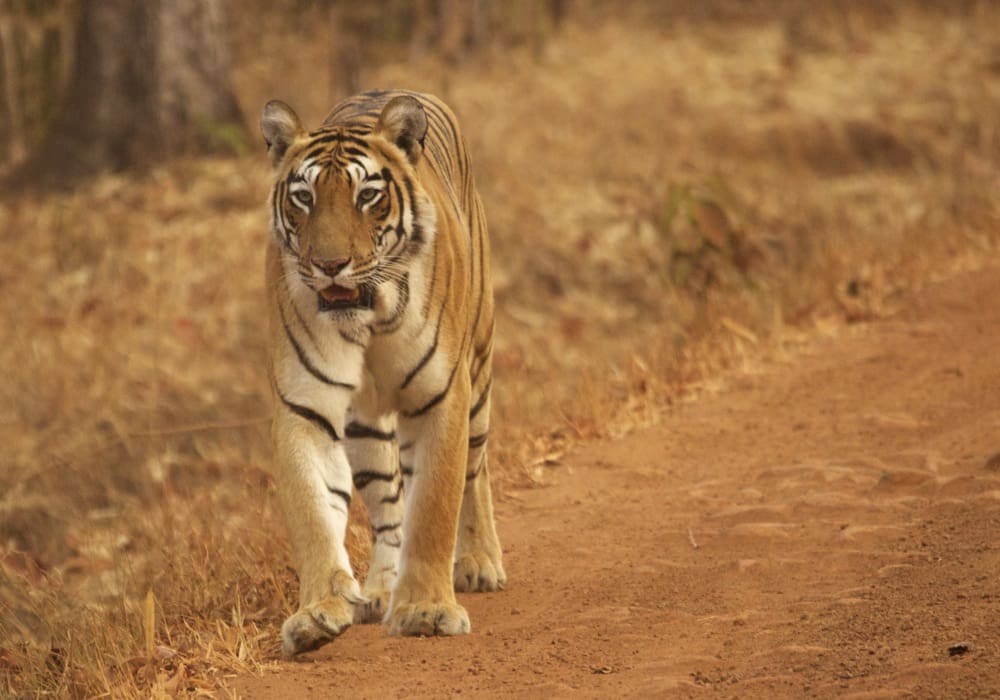
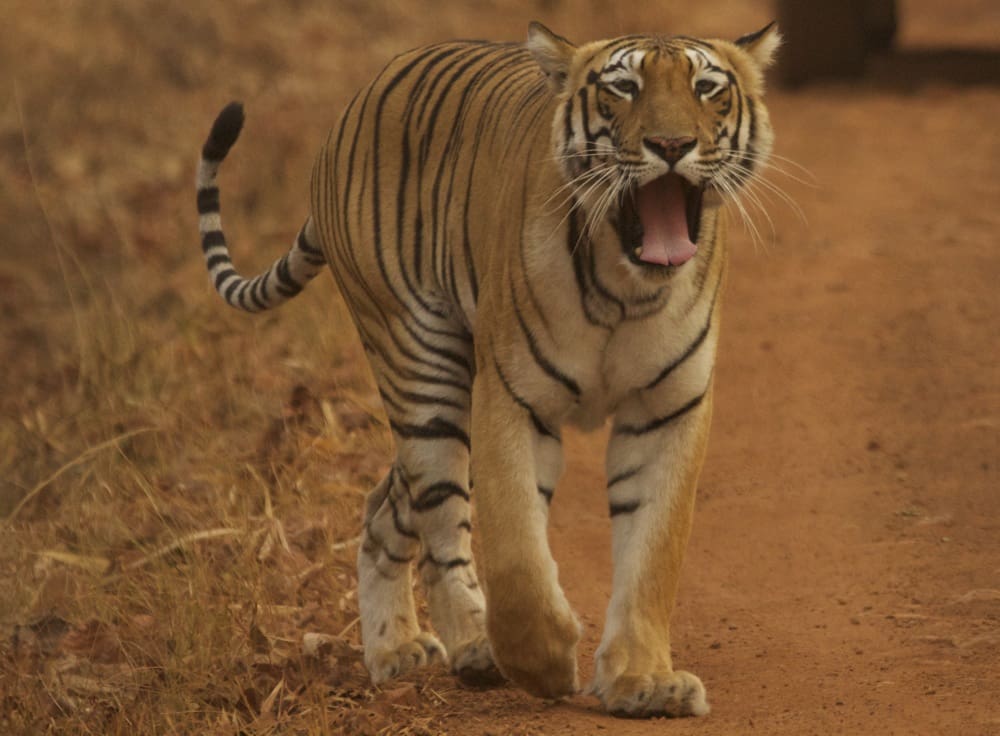
Our guide interpreted the tigress’s call and behaviour, stating that Choti Tara was warning her cubs not to follow her and stay concealed while she embarked on her weekly round to mark her territory. He further mentioned that tigresses with cubs embark on these weekly visits and leaving markings in their territory to prevent encroachment by other tigresses. Marking territory is important for a tiger to keep out competition for the prey base in its territory. Dr Ullas Karanth, in his book The Way of the Tiger, observed that a tiger feeding its cubs must hunt at least 70 ungulate-size prey in a year to meets her and her cubs’ nutritional needs. An adult tiger would otherwise hunt about 55 prey a year.
Dr Karanth also mentions that male cubs leave their mother’s protection when they turn two. One reason for this is to prevent inbreeding. After this, they spend years leading a life of transit, surviving in the buffer zones, hunting and getting stronger until they are in a position to challenge a dominant male and stake out a territory of their own. Considering the daunting challenges a tiger faces from being a cub to a sub-adult, all the way to adulthood, it is clear that the cubs would have to get better at their hunting skills as they grow.
While Choti Tara is the attraction at Jamni because of the handsome cubs she is bringing up, few might realize that being a tiger mother, as with all maternal responsibilities, is a full-time job. Hunting, teaching her cubs to hunt, protecting her cubs, protecting her prey base from competition — all of this packed into a day’s work. It’s easy to understand her reasons for denying the motley bunch of tourists an audience with her cubs.
Happy Mother’s Day!
Photographs and text: Andy
- Kutch Diaries – Spying on the elusive Desert Cat - June 10, 2020
- Kutch Diaries: Up close with the raptors of Banni - May 24, 2020
- Kutch Diaries – Going Waku Waku with Sandgrouse in Banni - April 29, 2020

